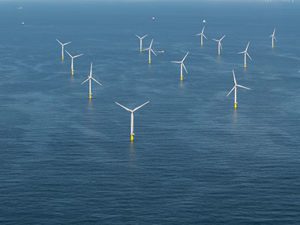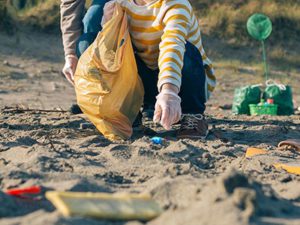Jump to:
NEW! Browse an overview of actionable interventions for ocean issue areas. Jump down the page to the Solutions Typology Table
Overview
There is increasing evidence that stakeholders are making notable gains in marine conservation. An illustrative snapshot of these wins include a growing proportion of sustainably managed fisheries around the world; renewed commitment and action on an ambitious global deal for ocean protection; deepened understanding, dialogue, and practice in leveraging ocean-based actions to provide clean energy and reduce the impacts of climate change; breakthroughs in technology and governance that provide greater transparency and accountability to the fishing sector; and a growing understanding of how to implement conservation strategies effectively, including by incorporating the social sciences and behavior change to ensure that solutions are culturally appropriate and durable.
These examples should be lifted up as beacons of best practice and learning to get beyond the “stickiness” of negative headlines and to ground this work from a stance of opportunity and action.1 It is true that enormous challenges remain for the ocean: the marine environment is experiencing rapid change and unprecedented threats, from increased user demands and resource claims to the impacts of climate change, overfishing, pollution, biodiversity and habitat loss, and several emerging threats. For this very reason, the marine conservation community must rapidly accelerate progress, as scientists warn that this is the decisive decade for action and implementation, particularly in tackling the climate crisis.2
In this feature, Our Shared Seas has collected an inventory of interventions across key issue areas and provided an overview of the solutions landscape to help expand conversation and action on evidence-based ocean solutions.
Across these interventions, there are several shared themes when thinking about how to advance effective strategies and prioritize the allocation of resources and actions:
- There is no silver bullet to solving the multitude of ocean threats. This work requires sustained engagement with a “portfolio approach” of blending proven approaches with new insights and perspectives, particularly given the dynamic and synergistic interactions of threats.
- Even as the sector introduces new innovations and technologies which are vital to this work, we have the necessary tools for action. The key is to remove barriers to solutions, accelerate their implementation, and expand their reach to ensure that solutions become the norm rather than the exception. As a boost for this work, academic research is increasingly identifying not only what leads to conservation failure, but importantly, what leads to success and bright spots.3
- For funders and practitioners who must decide what to fund or where to engage, decision-making frameworks can help provide a model for prioritization. Dimensions for prioritizing engagement could include: a focus on individual species, ecosystems, regions, certain threats, or types of approaches (e.g., capacity and leadership, markets, policy engagement, finance, or advocacy). Criteria for weighing these dimensions may include likelihood of success, feasibility, scale of impact, biodiversity measures, timeline, and other practical considerations.
- The ocean-climate nexus is an area which is ripe for increased engagement by philanthropy, civil society, and policymakers. As a panel of leading marine experts framed it, “Climate change is the critical backdrop against which all future [marine] rebuilding efforts will play out.”4 Accelerated action is needed to reduce the ocean’s vulnerability to climate change while simultaneously advancing the ocean as an essential source of climate solutions.
- There is growing recognition that conservation, equity, and human-well being are intricately connected. Equity is garnering increased attention in the conservation field, yet it remains poorly conceptualized in both research and practice.5 Empirical research and practical application are needed to move beyond the rhetoric of triple bottom-line solutions and to understand the complex tradeoffs and dynamics of these interconnections, whether it relates to partnering with an Indigenous community in designating and implementing a Marine Protected Area, or supporting communities in “climate-proofing” fisheries management systems.
A landmark study recently found that substantial recovery of marine life and ecosystems could be achieved by 2050, assuming that threats (particularly climate change) were abated.6 This recovery would require a roughly 2.4 percent annual improvement in key metrics and an estimated investment of USD 10 to 20 billion per year.7
To get informed on solutions-oriented opportunities for the ocean, we invite you to explore our compiled Typology table and individual chapters for a deep dive on the solutions landscape by issue area. In these chapters, we also highlight knowledge gaps, areas of emerging interest and research, and outstanding questions for the field to help guide conservation practice, research, and philanthropy.
How to Use This Resource
This table and the accompanying resources feature interventions for addressing threats to marine and coastal ecosystems globally. These resources provide a comprehensive, though not necessarily exhaustive, snapshot of ocean interventions that can orient new entrants to the field and provide seasoned practitioners with a model for mapping interventions across respective threat areas. We hope that this open-access resource can be a tool for the marine conservation community to iterate on as a living document and expand the conversation around ocean solutions.
The table below provides an illustrative synthesis of intervention categories across five respective issue areas. Cells with icons indicate that intervention examples exist within that category. If a cell is blank without an icon, it means that our methodology (described in further detail below) did not capture interventions within that category—although they may exist based on other methodologies.
Typology
Methodology
These materials were developed by CEA Consulting, drawing on existing frameworks, evidence synthesis projects, a targeted literature review, and a light review process by an expert panel. Staff from the Center for Biodiversity and Conservation provided expert guidance on the development and implementation of the methodology, which was framed as a non-systematic review due to time limitations. This exercise does not seek to systematically or comprehensively assess evidence for effectiveness (e.g., direction, magnitude, and distribution of impact).
For the core framework, we adopted the Intervention Categories and Intervention Subcategories from the peer-reviewed paper by Brooks et al (2020)8 which itself was based on the IUCN’s Conservation Measures Partnership (CMP) Conservation Actions Version 2.0. We modified this framework to add one additional Intervention Category: Infrastructure, Services, and Technology. For each chapter, CEA developed intervention examples based on a targeted review of literature and building upon previous intervention maps by our team, as well as the collective professional experience of our staff. To reduce bias and incorporate external feedback, a panel composed of marine conservation practitioners and academic experts provided feedback on the typology tables, which was integrated into the final output.
As issues of adequate governance, social equity, and justice are key elements to understanding the impact of conservation interventions and long-term sustainability, we consider these themes to be cross-cutting across all interventions. These cross-cutting themes are included where possible in the individual typology tables. We also look forward to providing more in-depth content coverage of these themes through periodic updates on Our Shared Seas.
Notes
- Ledgerwood A, Boydstun AE. “Sticky prospects: loss frames are cognitively stickier than gain frames.” 2014. Exp. Psychol. 143:376–85; Knowlton, Nancy. “Ocean Optimism: Moving Beyond the Obituaries in Marine Conservation.” Annual Review of Marine Science 13, no. 1(January 3, 2021). https://doi.org/10.1146/annurev-marine-040220-101608.
- IPCC, 2019: Summary for Policymakers. In: IPCC Special Report on the Ocean and Cryosphere in a Changing Climate [H.-O. Pörtner, D.C. Roberts, V. Masson-Delmotte, P. Zhai, M. Tignor, E. Poloczanska, K. Mintenbeck, M. Nicolai, A. Okem, J. Petzold, B. Rama, N. Weyer (eds.)].
- Knowlton, Nancy. “Ocean Optimism: Moving Beyond the Obituaries in Marine Conservation.” Annual Review of Marine Science 13, no. 1 (January 3, 2021). https://doi.org/10.1146/annurev-marine-040220-101608.
- Duarte, Carlos M., Susana Agusti, Edward Barbier, Gregory L. Britten, Juan Carlos Castilla, Jean-Pierre Gattuso, Robinson W. Fulweiler, et al. “Rebuilding Marine Life.” Nature 580, no. 7801 (April 2020): 39–51. https://doi.org/10.1038/s41586-020-2146-7.
- Meth, Leah and Bennett, N. “DEI-Social Science Learning Agenda: An introduction to social science research on conservation and equity.” Unpublished manuscript. 2020.
- Duarte, Carlos M., Susana Agusti, Edward Barbier, Gregory L. Britten, Juan Carlos Castilla, Jean-Pierre Gattuso, Robinson W. Fulweiler, et al. “Rebuilding Marine Life.” Nature 580, no. 7801 (April 2020): 39–51. https://doi.org/10.1038/s41586-020-2146-7.
- Ibid.
- Brooks, W.R., Rudd, M.E., Cheng, S.H. et al. Social and ecological outcomes of conservation interventions in tropical coastal marine ecosystems: a systematic map protocol. Environ Evid 9, 9 (2020). https://doi.org/10.1186/s13750-020-00193-w.



